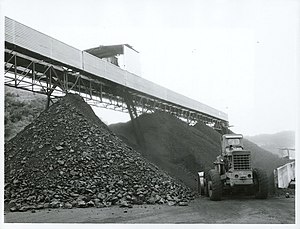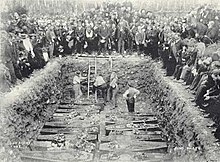Coal in New Zealand

New Zealand coal reserves are in excess of 15 billion tonnes, mainly in Waikato, Taranaki, West Coast, Otago and Southland. Over 80% of the reserves are in Southland lignite deposits. These were worth $100 billion in 2010.[1]
Some Maori tribes had known of coal (waro) and its use as cooking fuel,[2] but large-scale mining only commenced with arrival of European settlers.
Geology
The types of coal found in New Zealand include lignites, sub-bituminous, bituminous and semi-anthracite coals.[3] However, the geology of many coal fields can be complex, with significant structural tectonic disturbances caused by many fields being found near the boundaries between the Pacific and Indo-Australian tectonic plates that run through the country.[3] Unlike most of the world's coals, which are typically 300 to 350 million years old, New Zealand coals were formed between 30 and 70 million years ago.[4] This age difference means New Zealand coals have some valuable properties for specialist uses.[4]
Mining

Coal mining by Europeans commenced in New Zealand during the 1840s. It was conducted using hand tools until the early 1900s, when explosives and tools powered by compressed air began to be used. Most coal mining since the early 2000s has used open-cut techniques.[5]
Underground mining for coal is dangerous, and has led to many deaths and injuries in New Zealand. In March 1896, 65 coal miners were killed during the Brunner Mine disaster; as of 2021 this remained New Zealand's most deadly industrial accident. The Pike River Mine disaster in November 2010 caused the deaths of 29 coal miners.[5]
Climate change
Burning coal for electricity contributes to New Zealand's greenhouse gas emissions.[6][7] The Climate Change Commission has recommended that the use of coal be "phased out as soon as possible".[8] The New Zealand government has a goal of ending the use of coal and other non-renewables for power generation by 2030.[9]
In 2020 New Zealand imported 1.084 million tonnes of coal, of which 90 per cent was sourced from Indonesia and the remainder from Australia. Almost all of the imports were sub-bituminous coal, which produces large quantities of carbon emissions when burnt.[9] Two-thirds of the imported coal was used by the Huntly Power Station, with the remainder being used by New Zealand Steel and Golden Bay Cement.[8]
In May 2023 the New Zealand Government announced that New Zealand Steel would be provided with $NZ140 million in subsidies to transition away from burning coal as part its production processes; it is estimated that this will reduce New Zealand's total greenhouse gas emissions by one per cent.[10] In June that year the government implemented a policy which includes banning the installation of new low and medium temperature coal boilers from July 2023 and phasing out existing such boilers by 2037.[11]
See also
References
- ^ Cumming, Geoff (6 March 2010). "Miners press to enter the green zone". The New Zealand Herald. Archived from the original on 2 April 2012.[page needed]
- ^ Ngāti Tamaoho settlement pp. 34–5 cited in Down, Sarah (2018). Māori and Minerals: Debating Rights (PhD thesis). Australian National University. p. 323.
- ^ a b Royal Commission on the Pike River Coal Mine Tragedy (October 2012). "Report: Volume 2: Part 2: Chapter 19: Coal mining in New Zealand" (PDF). pikeriver.royalcommission.govt.nz. Wellington, New Zealand: Royal Commission on the Pike River Coal Mine Tragedy Te Komihana a te Karauna mō te Parekura Ana Waro o te Awa o Pike. p. 254. Retrieved 24 September 2023.
- ^ a b Sherwood, Alan; Phillips, Jock (14 April 2021) [First published 12 June 2006]. "Coal and coal mining – The nature of coal". teara.govt.nz (Te Ara – the Encyclopedia of New Zealand). Wellington, New Zealand: Manatū Taonga Ministry for Culture and Heritage. p. 1. Retrieved 24 September 2023.
- ^ a b Sherwood, Allan; Phillips, Jock (14 April 2021). "Story: Coal and coal mining". Te Ara: The Encyclopedia of New Zealand. Ministry for Culture & Heritage. Retrieved 24 September 2023.
- ^ "New Zealand's energy-related emissions". EECA. Retrieved 24 September 2023.
- ^ "New Zealand's greenhouse gas emissions | Stats NZ". Stats NZ Tatauranga Aotearoa. 27 October 2022. Retrieved 24 September 2023.
- ^ a b Bond, Jordan (26 July 2021). "New Zealand likely to have 'record high imports' of coal in 2021 – officials". RNZ. Retrieved 24 September 2023.
- ^ a b Bond, Jordan (14 July 2021). "NZ imported more than a million tonnes of 'dirty' coal last year". RNZ. Retrieved 24 September 2023.
- ^ Neilson, Michael (21 May 2023). "Govt to spend $140m on NZ Steel's move away from burning coal". New Zealand Herald. Retrieved 24 September 2023.
- ^ Woods, Megan (30 June 2023). "Government ban on new coal boilers in place". The Beehive. Retrieved 24 September 2023.
Further reading
- Richardson, Len (1995). Coal, Class & Community: The United Mineworkers of New Zealand, 1880–1960. Auckland University Press. ISBN 978-1-86940-113-9 – via Google Books.
- Royal Commission on the Pike River Coal Mine Tragedy (October 2012). "19". Coal mining in New Zealand (PDF). Wellington, New Zealand. pp. 254–257. ISBN 978-0-477-10378-7.
{{cite book}}: CS1 maint: location missing publisher (link)
External links
- Sherwood, Alan; Phillips, Jock (14 April 2021) [First published 12 June 2006]. "Coal and coal mining". teara.govt.nz (Te Ara - the Encyclopedia of New Zealand). New Zealand Ministry for Culture and Heritage Te Manatu Taonga. Retrieved 23 December 2022.
- "Royal Commission into the Pike River Mine Tragedy". pikeriver.royalcommission.govt.nz. Retrieved 23 September 2023.

